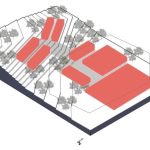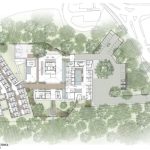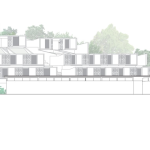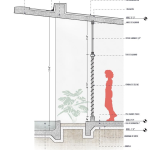Custodial Architecture: Integration of the architectural space in the intervention with the victims of domestic violence
“El hogar, espacio que alguna vez fue seguro, cómodo, propio, es ahora un lugar de dolor. Por lo que, es posible concluir que el espacio arquitectónico juega un papel importante en la vida de las víctimas”. – Nelmaris Camacho García, 2020.
Designer: Nelmaris Camacho García
Thesis Committee Director (s): Dra. Mayra O. Jiménez Montano
Thesis Committee Consultant (s): Arch. Robin Planas & Dra. Ruth Nina Estrella
Location: Aguas Buenas, Puerto Rico
Completion Date: December 2020
TOS [er]: Alejandra M. Ocasio Estrada
Posted: May 2022
About Custodial Architecture:
Camacho García understands the creation of any space for domestic violence survivors should pursue a sensitive architecture, which recognizes not only programmatic needs, but also integrates the creation of sensory experiences to help in the healing and empowerment process for victims of domestic abuse. The project Estancias Monserrate is a proposal that arises from the woman as the center of the space that surround her. The design takes into consideration the sensory aspects and the identity of the place as fundamental architectural conceptualization tool to generate richness and spatial quality. Thus, integrating the perceptual components, light, water, tectonics and landscape, a journey of moments is created that are formalized through patios, ponds, fountains and gardens, elements that are intended to generate a contiguous multisensory experience that surround the participants on a day-to-day basis during your stay.
[Keywords: Domestic violence, women and architecture, sensible architecture, architectural phenomenology, perceptual components]
Project description:
The increase in the number of domestic violence on the island and the declaration of an emergency alert by the government are conclusive events that legitimize the need for studies on domestic violence and the relationship between space and this type of social problem. Architecture, as a social project, has interference in these issues and as a discipline, it joins the search for alternatives that contribute to the eradication of this issue.
Objectives:
- Introduce the issue of domestic violence as a social problem within the context of the discipline of architecture.
- Explain how sensory experiences can make architecture a tool applicable to centers for victims of domestic violence.
- Maintain a reflective look at the analysis of the problem of domestic violence, as well as in the design process.
- Define the functional and programmatic needs of the shelters and service centers in Puerto Rico.
- Define strategies and design criteria according to the research done.
Methodology:
The investigation uses the search for information on laws, statistics, directories, and any other relevant information on domestic violence in Puerto Rico, to establish the general status of the same. In addition, through the web pages the services and types of support offered by the various programs, centers and hostels on the island will be studied. They visited shelters and assistance centers for victims of domestic violence. Through the generation of observation tools, qualitative and quantitative data was collected from the case studies. Under the qualitative scheme, they generated a memorial in which the spatial quality and sensory experience of the place was detailed. With the quantitative scheme, the program of each case study was compiled, as well as the programmatic relationship and the spatial sequence. Finally, photomontages were presented to capture the essence of the place and a comparison between the case studies that was generated, and from there, design criteria were outlined.
Design Strategies:
The influence of phenomenology in architecture has arisen from the set of disciplines, thinkers, and intellectual events throughout history. We experience architecture with all the senses. Architecture for women must move away from the practical sense of functional-programmatic relationships and focus on building an experiential sequence that surrounds it and at the same time includes it as the center of its creation. This search to propose a sensitive architecture is extremely important for women, but especially for victims of domestic violence, since their daily experiences have built painful spatial memories. Therefore, it is necessary to transform those memories and turn them into pleasant physical and sensory experiences.
Perceptual Components:
- Light and shadow. The interest in the inclusion of light as an entity inherent to architecture is one of the most important aspects of practical phenomenology.
- Texture and color. The spatial qualities that fill the space of character, can create an interesting sensory impact. Unlike other perceptual elements, color has a close relationship with identity and culture.
- Unlike other perceptual components, it can activate two senses at the same time, through the fall of the water, a constant and reassuring sound is generated that adds a sacred aspect to the work.
- Is an integral part of the design process and goes beyond the use of the winds or the sun, but rather connects us with the identity of the site. In this exchange, we become part of the spirit of the place, and we re-signify it.
Project Program:
- El Recibimiento
- Reception
- Administration
- Meeting Spaces
- Social Worker Offices
- Entrance Garden
- Legal Aid Office
- La Red
- Kitchen
- Gym
- Laundry
- Circle of Silence
- Dining Room
- Playground
- Study Area
- Central Garden
- El Retiro
- Rest Space
- Pocket Terrace
TOS [er] Reaction:
This subject of this thesis is incredibly important to discuss and integrate in our academic curriculums and in our architecture practice. The archipelago of Puerto Rico is still dealing with an outrage number of domestic violence, and now we are seeing an increase of violence against trans persons. The importance of designing and creating inclusive and safe spaces has never been as important as the current political situation. Not only that, but we are also going through a global pandemic where we have seen recurrent lockdowns in many communities which leads us to the next questions: what happens to the people that don’t feel safe in their homes? What are we doing to protect all the members of our communities?
As a colony, our culture was based in the necessities of a group of people and a context that doesn’t fit the necessities we have as a tropical archipelago. It is time to misappropriate the culture of hegemony design and create safe and inclusive spaces that consider and integrate the intersectionality that occurs with the social inequalities we still see in our society. These solutions clearly must be considered in a collaborative study with other disciplines and experts, to assure a proper result.








